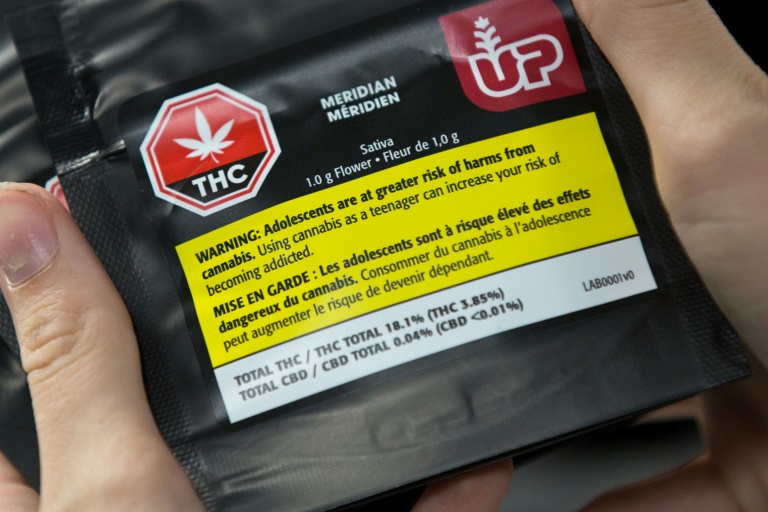
Canada will end its pot prohibition Wednesday with the goals of curbing the black market and use by youth, amid concerns around the public health and safety merits of legalization.
Public health officials contend that smoking cannabis is as harmful as tobacco, but welcome the opportunity legalization affords for open dialogue.
Police, meanwhile, are scrambling to prepare for a predicted rise in drug-impaired driving and are not yet ready to lay three new charges, which require blood tests within two hours of being pulled over to show above-limit levels of THC, the psychoactive agent in cannabis.
“As a doctor and as a father, I do not agree with the legalization of recreational cannabis,” said Antonio Vigano, a medical marijuana specialist and research director at the Sante Cannabis clinic in Montreal, citing the risk of increased consumption among young people.
“There are health concerns,” Gillian Connelly of the Ottawa Public Health Agency told AFP. “But legalization is creating an opportunity to have discussions about cannabis use, for example, parents starting a conversation with their kids about it.”
“For decades, we’ve said: ‘Just don’t use,’ but that hasn’t worked,” she said.
This failed messaging has helped to make Canadians among the highest per capita users of cannabis, with 4.6 million or one in eight having consumed pot this year (including 18 percent of Ottawa youth).
There are now hundreds of millions of dollars in funding available for education, and, Connelly said, “a concerted effort to get information out to people about the harms of cannabis.”
“People will also have information about what they’re consuming, with THC levels on the package, in order to make informed decisions about how much is okay for them to consume,” she said.
Driving while high
The government sent a mailer to 14 million households outlining the basics, including health warnings and the need to keep cannabis away from children and pets.
Mothers Against Drunk Driving also partnered with Uber and pot grower Tweed in a campaign against high-driving.
Connelly noted a brief spike in hospitalizations after the US state of Colorado legalized cannabis in 2014, attributed to people not realizing its potency. THC has risen from an average of three percent in the 1980s to 15 percent today.
“Our message is to start low and go slow,” she said.
Employers, meanwhile, are setting a wide range of restrictions on its use affecting work. The military, for example, has ordered soldiers not to use cannabis eight hours before a shift, while some police and airlines have announced bans.
Officials urged updating workplace policies, but acknowledged a patchwork of court decisions on employee drug screening has created challenges for employers.
Teenage tokers
In addition to legal gray zones, there is a dearth of scientific data on cannabis, which has made policy-setting harder.
This became apparent when officials dismissed doctors’ concerns about pot’s impact on developing brains under 25, and set the minimum age for consumption at 18 or 19 in line with the legal age for alcohol.
A panel that recommended the framework for legalization to the government said the “current science is not definitive on a safe age for cannabis use.”
It also determined that setting the bar at 25 would undercut efforts to eliminate the black market, which in turn would undermine providing a safer product to consumers.
Connelly said she hopes legalization will spur research. Many of the current policies around cannabis, she noted, are based on alcohol and tobacco.
For policing, corresponding consumption to impairment also remains hazy.
To get around this, the government set limits of blood drug concentrations at, or over 2 nanograms of THC but under 5 ng; 5 ng and over; and 2.5 ng combined with 50 mg alcohol per 100 ml of blood, so prosecutors don’t need to prove impairment.
“For people who drive, we know that the presence of THC is a risk for attention, concentration, judgement,” said Vigano.
But most forces do not yet have dedicated staff for taking blood samples.
Officers are being trained to use alternative roadside saliva testers for detecting THC, approved in August.
But some forces, including the Ottawa Police Service, are opting not to use them over concerns about costs (Can$6,000 each), their effectiveness in the cold and their admissibility in court.
“It functions best at temperatures from 4 degrees to 40 degrees (Celsius). In winter, which can stretch from October to April in this part of Canada, it may present challenges,” said Ottawa police Constable Amy Gagnon.
A Senate brief noted that drug-impaired driving cases take twice as long to litigate compared to alcohol-impaired driving cases, and are less likely to result in a guilty verdict.
Meanwhile, the government is hoping that undercutting traffickers on price will simply put them out of business.
But the proposed after-tax pricing is above the average Can$6.74 (US$5.16) per gram on the black market, according to Statistics Canada.
For Jean-Sebastien Fallu, an addiction specialist at the University of Montreal, the risks do not outweigh the virtues of legalization.
“Cannabis is not good for health, but prohibition is extremely harmful and worse than cannabis,” Fallu said, citing the “catastrophic consequences” of “stigmatization, violence, crime (and) illicit economy.”




